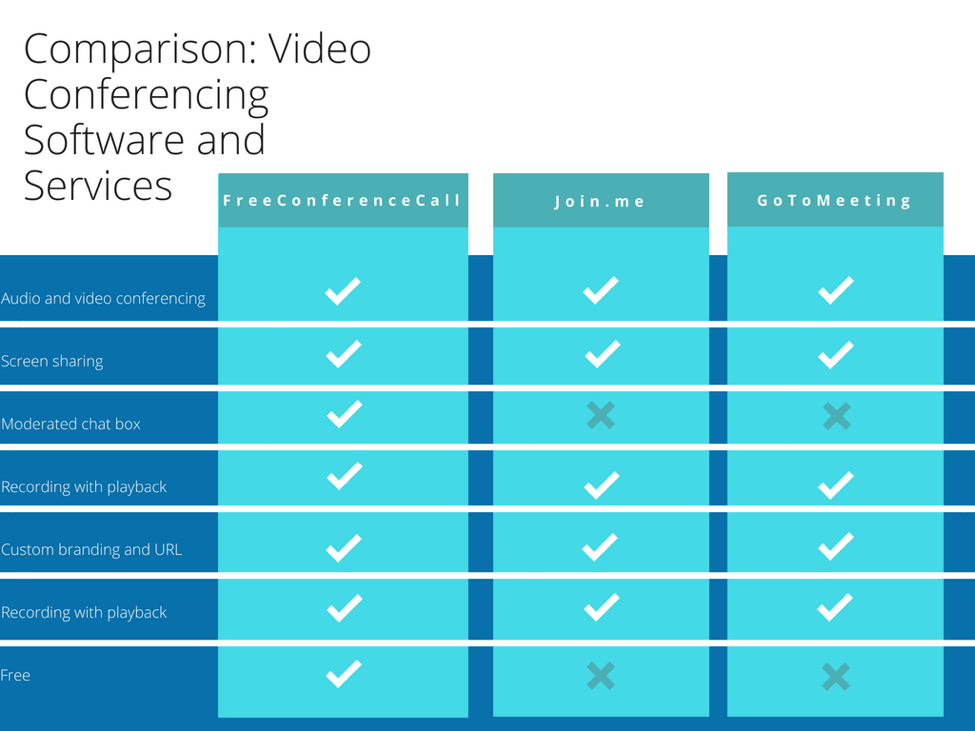Video conferencing is becoming an increasingly viable method of communication for businesses both small and large, but it’s important to understand exactly what its advantages and disadvantages are.
Seven advantages of video conferencing include:
1. Saves time and money.
2. No traveling required.
3. Brings remote workers and telecommuters together.
4. More personal and engaging than phone conferencing alone.
5. Increased efficiency and productivity.
6. Cuts down on carbon emissions.
7. Improves relationships.
What Is Video Conferencing and How Does It Work?
Simply put: video conferencing is a method of communication that uses the web to connect a group of people via a live video and audio feed. Video conferences are held with the help of video conferencing software and services, such as FreeConferenceCall.com, join.me or GoToMeeting, to name a few.
What Are the Benefits of Video Conferencing?
Video conferencing offers a wealth of benefits to businesses of all sizes across a multitude of industries and sectors. We will be reviewing video conferencing advantages and disadvantages and the types of video conferencing available today.
Let’s take a closer look at some of the biggest benefits:
- Saves Time and Money
Consider for a moment the costs associated with a traditional face-to-face meeting. For a meeting that participants must travel to attend, costs can add up quickly.
Even in-office meetings can come with an array of costs, including the paid time employees spend setting up the meeting and waiting for latecomers to arrive.
All of these costs add up to some big numbers: In a study published in the European Journal of Work and Organizational Philosophy, researchers from multiple universities found that businesses waste approximately $37 billion on ineffective meetings every year. - No Traveling Required
Traveling to attend a meeting isn’t just costly—it can also be incredibly inconvenient and taxing. Even if the travel time is as short as 30 minutes, it will inevitably eat up valuable time that could otherwise be spent accomplishing important tasks or preparing for the meeting. - Brings Remote Workers and Telecommuters Together
With 43 percent of employed Americans working remotely at least some of the time, more people are working remotely [than ever before](https://www.nytimes.com/20https://carrierx-mediablog-dev.noveogroup.com/apimote-workers-work-from-home.html). So, it’s important for businesses that employ remote workers and telecommuters to bring those employees together in a way that doesn’t rely on face-to-face meetings. (See No. 7 on this list for more benefits to remote workers.) - More Personal and Engaging Than Phone Conferencing Alone
Although conferences conducted over the phone can allow for effective communication in many situations, video conferencing is unique in that it allows participants to see each other’s body language. Studies have found that communication relies on body language between 55 percent and 70 percent of the time. - Increased Efficiency and Productivity
The combined effect of many of the advantages of video conferencing—such as less time and money wasted, increased personal connection and a lack of travel—is a greater level of efficiency and productivity. After all, if attendees are spending the bulk of their time actually participating in a meeting rather than preparing for it, traveling to it or waiting for other participants to arrive, it makes sense that efficiency and productivity will go up. - Cuts Down on Carbon Emissions
Since adopting greener business practices can save money, attract consumers and improve reputation (in addition to helping the environment, of course), [10 percent more companies](https://www.greenbiz.com/article/state-green-business-2018) have set carbon and water targets over the past five years. Given that transportation accounts for [28 percent](https://www.epa.gov/ghgemissions/sources-greenhouse-gas-emissions) of the country’s greenhouse gas emissions, it’s clear that businesses who adopt video conferencing can significantly cut down on their carbon emissions and save money in the process. - Improves Relationships
Happy workers are up to 20 percent more productive than unhappy workers, and it goes without saying that any business can benefit from increased productivity. So, what makes workers happy? For one, positive workplace relationships: 67 percent of workers say that having friends at their job makes work more fun and enjoyable. Since video conferencing is an excellent way to build professional relationships with colleagues and clients alike, it’s worth your while to consider video conferencing as a means of improving workplace relationships—especially for remote workers.
What Are the Disadvantages of Video Conferencing?
Like any other form of communication, video conferencing also comes with its own unique set of disadvantages. Some drawbacks include:
- Requires participants to possess a basic level of tech literacy Although participating in a video conference is certainly not as technologically advanced as other tasks, it still requires attendees to have a foundation of technical knowledge.
- Can be less personal than a face-to-face meeting While video conferencing is generally more personal than a conference that’s conducted over the phone, it does have the potential to be less personal than a face-to-face meeting, especially if some attendees aren’t actively participating.
- Potential for technical difficulties A successful video conference relies on several stable and high-speed internet connections, as well as multiple properly functioning computers, webcams and microphones. That’s a lot of variables. Knowing this, it’s not hard to see how a video conference can be delayed or detoured by technical difficulties.
What Video Conferencing Software and Services Are Available?
A quick search engine query will reveal a myriad of video conferencing software and services.
However, very few of those offer a complete suite of features for free. Here, we’ll compare the cost and features of some of the top video conferencing services:

As you can see, while the top video conferencing services and software have many of the same features, it can be difficult to find on that’s truly free.
When comparing the advantages and disadvantages of video conferencing, the benefits generally outweigh the drawbacks. For many businesses, video conferencing can be a low-cost (or even free) way to bring people together, increase productivity and save money.
To learn how you can host high-quality video conferences for free, learn more about FreeConferenceCall.com’s video conferencing tool.


